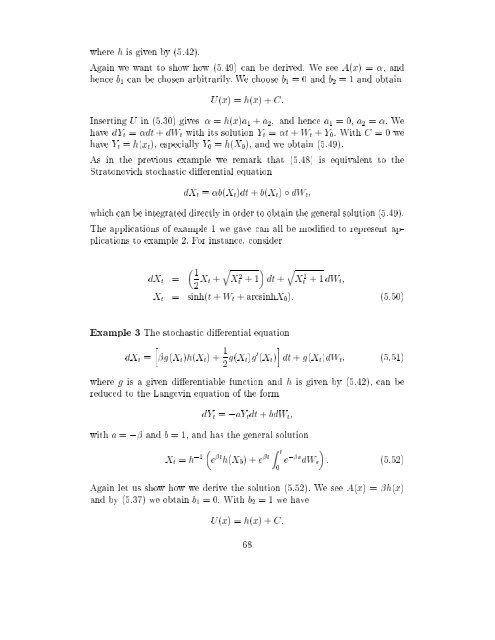Estimation in Financial Models - RiskLab
Estimation in Financial Models - RiskLab
Estimation in Financial Models - RiskLab
Create successful ePaper yourself
Turn your PDF publications into a flip-book with our unique Google optimized e-Paper software.
where h is given by (5.42).<br />
Aga<strong>in</strong> we want to show how (5.49) can be derived. We see A(x) = , and<br />
hence b 1 can be chosen arbitrarily. We choose b 1 =0and b 2 = 1 and obta<strong>in</strong><br />
U(x) =h(x)+C:<br />
Insert<strong>in</strong>g U <strong>in</strong> (5.30) gives = h(x)a 1 + a 2 ; and hence a 1 =0,a 2 = . We<br />
have dY t = dt + dW t with its solution Y t = t + W t + Y 0 . With C =0we<br />
have Y t = h(x t ), especially Y 0 = h(X 0 ), and we obta<strong>in</strong> (5.49).<br />
As <strong>in</strong> the previous example we remark that (5.48) is equivalent to the<br />
Stratonovich stochastic dierential equation<br />
dX t = b(X t )dt + b(X t ) dW t ;<br />
which can be <strong>in</strong>tegrated directly <strong>in</strong> order to obta<strong>in</strong> the general solution (5.49).<br />
The applications of example 1 we gave can all be modied to represent applications<br />
to example 2. For <strong>in</strong>stance, consider<br />
dX t =<br />
1<br />
q q<br />
2 X t + Xt 2 +1 dt + Xt 2 +1dW t ;<br />
X t = s<strong>in</strong>h(t + W t + arcs<strong>in</strong>hX 0 ): (5.50)<br />
Example 3 The stochastic dierential equation<br />
<br />
dX t = g(X t )h(X t )+ 1 <br />
2 g(X t)g 0 (X t ) dt + g(X t )dW t ; (5.51)<br />
where g is a given dierentiable function and h is given by (5.42), can be<br />
reduced to the Langev<strong>in</strong> equation of the form<br />
dY t = ,aY t dt + bdW t ;<br />
with a = , and b = 1, and has the general solution<br />
X t = h ,1 <br />
e t h(X 0 )+e t Z t<br />
0<br />
e ,s dW s<br />
<br />
: (5.52)<br />
Aga<strong>in</strong> let us show how we derive the solution (5.52). We see A(x) = h(x)<br />
and by (5.37) we obta<strong>in</strong> b 1 =0.With b 2 =1we have<br />
U(x) =h(x)+C:<br />
68
















